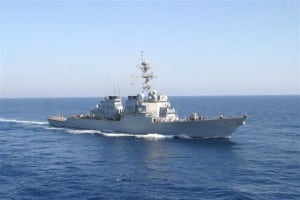
Destroyer Multi-Year. Acting Secretary of the Navy Thomas Harker told a Senate panel the service plans to sign another multi-year procurement contract for Arleigh Burke-class (DDG-51) Flight III destroyers amid an administration budget request that is seeking only one new destroyer in FY ‘22 despite promises to buy two per year. “Multi-year contracts are very important to us. We do intend to sign another multiyear for DDGs starting in ‘23 thru ‘27 and continue that procurement into the foreseeable future,” Harker said June 24 during a hearing before the Senate Appropriations Defense subcommittee. Harker added the Navy is committed to continuing multi-year procurement contracts for both attack submarines and destroyers.
…Affordability. Harker reiterated that while DDG-51s are “a very valuable asset for us,” the Navy struggled with the decision to procure only a single DDG-51 in the budget request. “It was the hardest decision we made and we would love to have been able to include it…Over the last multi-year period it was a 10 ship multi-year over a five-year period. With the assistance of the committees and the Congress we were able to purchase 10 ships so the one that’s in our budget this year will be an 11th ship. That gave us the ability to not buy the DDG this year, but it was a very difficult decision for us.” Chief of Naval Operations Adm. Mike Gilday added that “it was absolutely an affordability issue, we fought for that hull right to the bitter end.” Gilday said in order to pay for the second destroyer given the same budget topline restrictions, after the Navy is already planning to decommission 15 ships, they would have to take funds out of manpower, spare parts, and ammunition. “It really did come down to priorities, as difficult as it was to break the multi-year and to send mixed signals to industry. It really did come down to prioritizing the investments that we had to make right now in the fleet that we have today,” Gilday continued.
Air Force’s JADC2 Battle Lab. The Joint Chiefs of Staff have named the Shadow Operations Center-Nellis (ShOC-N) at Nellis AFB, Nev. as the U.S. Air Force’s Joint All Domain Command and Control (JADC2) battle laboratory. The latter is to aid the development of the Advanced Battle Management System, the service’s component of JADC2, which is to be a military Internet of Things. Defense Secretary Lloyd Austin recently approved the Pentagon’s JADC2 strategy. ShOC-N, so named because the Air Force says the center is able to connect to any operations center, is to spur the U.S. military’s decision speed advantage against China and Russia across air, space, land, sea, and cyber domains. Air Force Lt. Col. David Spitler, the commander of the 805th Combat Training Squadron, said that there are “an unforgivable number of [data] applications” for functions, like chat, managing coordinates, and generating maps. Spitler suggested consolidating that number of applications to accelerate command and control.
MilCon Earmarks. Earmarks are making their return to Congress, with several lawmakers receiving funding for “community project funding items” in the House Military Construction and Veterans Affairs Appropriations Subcommittee’s $280 billion fiscal year 2022 spending bill approved by the panel on June 25. The list of military construction earmark projects in the bill include Rep. Mike Rogers (R-Ala.), the House Armed Services Committee ranking member, requesting $25 million to the Army for a welding facility at Anniston Army Depot, a $36 million request from Rep. Mike Johnson (R-La.) to the Air Force for a new entrance road and gate complex at Barksdale Air Force Base, $17.5 million from Rep. Lisa Blunt Rochester (D-Del.) to the Air National Guard for a fuel cell and corrosion control hangar at New Castle County Airport in Delaware and Rep. Tony Gonzales (R-Texas) requesting $10 million to the Army for a vehicle maintenance shop at Joint Base San Antonio-Camp Bullis.
DoD Nominees Advance. The Senate Armed Services Committee on June 22 advanced five more nominees by voice vote. The list includes Caroline Krass to be the Pentagon’s general counsel, Gina Ortiz Jones to be Air Force under secretary, Dr. Ely Ratner, to be assistant secretary of defense for Indo-Pacific security affairs, Shawn Skelly to be assistant secretary of defense for readiness and Meredith Berger to be assistant secretary of the Navy for energy, installations and environment. The nominations were reported for consideration by the full Senate.
Truck Production. Mack Defense announced on June 24 it has begun producing the Army’s new Heavy Dump Trucks (HDTs) at its Mack Experience Center in Allentown, Pa. after investing $6.5 million to stand up a new production line at the facility. “The investment to create a dedicated HDT product line at the Mack Experience Center will increase production efficiencies. We are proud to continue the fulfillment of our current contract with the U.S. Army and support our armed forces,” David Hartzell, the company’s president, said in a statement. Production of the new HDTs at the Mack Experience Center started early this year, with the first vehicles delivered to the Army in May.
US-EU Cooperation. The U.S. and European Commission have agreed to create a new working group aimed at combating ransomware. The agreement was reached last week during a visit to Portugal by Homeland Security Secretary Alejandro Mayorkas with EU Commissioner Ylva Johansson for the biannual U.S.-EU Justice and Home Affairs Ministerial. A readout of Mayorkas’s trip provided by DHS said “This working group will help strengthen transatlantic cooperation to tackle ransomware more effectively, including through preventive and law enforcement measures.”
ESG Supply Chain Deal. Eastern Shipbuilding Group (ESG) has signed supplier Bayou Metal Supply to an exclusive materials and labor agreement to strengthen its bid for the next round of the Coast Guard’s offshore patrol cutter program. ESG said the agreement will keep the program on “budget and schedule” if the company wins the contract to supply next tranche of medium-endurance cutters. ESG is building the first four OPCs but the Coast Guard decided to recompete the program for ships five through 15. Bayou is a proven supplier to ESG for the first four ships and the company manufactures pre-fabricated aluminum panels that ESG assembles into complete hull structure units.
Second Fleet Nominee. On June 23, Secretary of Defense Lloyd Austin announced President Biden nominated Rear Adm. (upper half) Daniel Dwyer to be vice admiral and assigned commander of U.S. 2nd Fleet/Joint Forces Command Norfolk. Dwyer currently serves as director for Plans and Policy, J5 at U.S. Cyber Command. If confirmed, Dwyer would succeed Vice Adm. Andrew Lewis, who has served in the role since 2018. Dwyer has been in his current role at Cyber Command since July 2020 and previously served at chief of staff and assistant chief of staff for strategy, resources and plans for Commander (N5), U.S. Naval Forces Europe and Naval Force Africa and for Commander U.S. 6th Fleet.
…Merz Nomination. Austin on June 17 announced the president nominated Vice Adm. William Merz, commander of 7th Fleet, to be reappointed vice admiral and for assignment as deputy chief of naval operations for operations, plans and strategy, N3/N5. In this role he would succeed Vice Adm. Philip Sawyer, who has served in that role since October 2019. Merz has served as head of 7th Fleet since September 2019 and previously served as director of Undersea Warfare Division (OPNAV N97) and deputy chief of naval operations for warfare systems (OPNAV N9).
…Morley. Austin also announced Rear Adm. (upper half) Francis Morley was nominated to be vice admiral and assigned as principal military deputy assistant secretary of the Navy for research, development and acquisition (RDA). He currently serves as director of the Navy International Programs Office, which he has led since September 2016. Morley previously served as vice commander of Naval Air Systems Command and program manager for the F/A-18 and EA-18G program office (PMA-265). Morley is set to succeed Vice Adm. Michael Moran, who has been in the role at RDA since October 2018.
Target Practice. The Singapore Air Force (SAF) is to conduct its XFS21 exercise from Sept. 13 to 23 at Mountain Home AFB, Idaho and is looking to lease 24 Remotely Controlled Vehicles (RCVs) to allow SAF to practice against mobile targets, according to a U.S. Air Combat Command solicitation. The SAF is to use inert bombs, General Dynamics’ Hydra rockets fired from Boeing AH-64 Apache helicopters and 30 mm guns to engage the RCVs, per the notice.
Next AUSA President. AUSA announced on June 22 that Ret. Gen. Robert Brown, former commanding general of U.S. Army Pacific from 2016 to 2019, will serve as the group’s next president and CEO. Brown will succeed Ret. Gen. Carter Ham, who has led AUSA since 2016. “Carter Ham is an extraordinary leader whose wise stewardship of AUSA has been transformative. As all great leaders, Carter leaves AUSA even stronger than he found it. We have been fortunate to have as his replacement Bob Brown, who will continue to lead AUSA to new heights,” Phebe Novakovic, AUSA board chair and CEO of General Dynamics, said in a statement. Brown, who served in the Army for 38 years, joined AUSA in January as its executive vice president. “I’m humbled and very proud to be selected to lead the exceptional team at AUSA, an organization with a deep history and a strong record of support for the United States Army,” Brown said.
Cyber Award. Sabre Systems won an $11 million task order to provide full-spectrum cybersecurity research and analysis to support the Naval Air Warfare Center Aircraft Division (NAWCAD) AIRWorks, the company said June 22. The task order was awarded under the Defense Technical Information Center Information Analysis Center Multiple Award Contract. Sabre noted AIRWorks runs high-visibility special projects for the Navy for rapid fielding to meet “urgent warfighter needs.”
Cyber Workforce Bill. There appears to be no shortage of bipartisan congressional bills aimed at strengthening the federal government’s cybersecurity workforce. Add another to the mix. Last week. Sens. Maggie Hassan (D-N.H.) and John Cornyn (R-Texas) introduced the Federal Cybersecurity Workforce Expansion Act that would create a pilot program within the Department of Veterans Affairs to give cybersecurity training to veterans and establish an apprenticeship program in the Cybersecurity and Infrastructure Security Agency. “In order to bolster our cyber defenses and protect our critical infrastructure, we need to increase the number of cybersecurity professionals in the federal government,” says Hassan.













